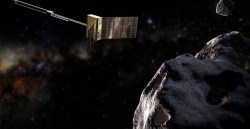
From Earth asteroids appear as little more than dots in the sky. Europe’s miniature APEX spacecraft will operate as a mineral prospector in deep space, surveying the make-up of its target asteroids down to individual boulders, helping prepare the way for future mining missions.
ESA’s proposed Hera mission for planetary defense will explore the twin Didymos asteroids, but it will not go there alone: it will also serve as a mothership for Europe’s first two ‘CubeSats’ into deep space.
CubeSats are nanosatellite-class missions based on standardized 10-cm boxes, making maximum use of commercial off the shelf systems. APEX, the Asteroid Prospection Explorer, will be a ‘6-unit’ CubeSat, selected to fly aboard Hera along with the similarly-sized Juventas, led by the Gomspace company.
APEX is being designed for ESA by a Swedish-Finnish-German-Czech consortium, representing a coming together of two CubeSat designs originally chosen to accompany Hera’s predecessor, the Asteroid Impact Mission.
“We’re a prospecting mission because we are focused on revealing the composition and structure of the Didymos asteroids,” explains Tomas Kohout of Helsinki University in Finland and The Czech Academy of Sciences.
“Our Asteroid Spectral Imager will perform detailed spectral measurements of both asteroids on a global basis. It will record the sunlight reflected by Didymos and break down its various colors to look for distinctive absorption ‘fingerprints’, to help map the surface makeup. We’ll obtain a full spectrum for each pixel we see, to make comparisons with terrestrial meteorite samples.”
Another instrument, the Secondary Ion Mass Analyser, will gather data from the constant interaction of the asteroid surfaces with the solar wind from the Sun.
“Incoming ions from the solar wind trigger a sputtering of ions of various elements such as silica, iron and magnesium,” comments Jan-Erik Wahlund of the Swedish Institute of Space Physics. With this data, we can gather the elemental composition of the asteroids.
“Between these two instruments, we also hope to see how these asteroids have interacted with the space environment, pinpointing any differences in composition between the two. And we will closely image the impact crater left by the US DART’s spacecraft’s asteroid deflection test and the ejecta deposited across both surfaces.”
The first stage of its approximately two-month-long mission will involve global surveys of the two asteroids from around 4 km away.
After a couple of weeks, APEX would then close in on the smaller of the two asteroids, to close in within 500 m of ‘Didymoon’. At this point, the CubeSat will make use of localized Lagrange points, gravitationally stable points within the Didymos system. During this ‘inner system science operations phase,’ a third instrument would come into play: a magnetometer mounted on a boom away from the main CubeSat body, to maximize its sensitivity.
“At close proximity to Didymoon the magnetometer can separate the interplanetary solar wind from the magnetization of the asteroid itself,” adds Jan-Erik.
“This will tell us if there are magnetic minerals within it. By extension it will also give us an idea of the asteroid’s internal structure: if there is a single magnetic dipole resembling Earth’s, then the asteroid is a single monolith. If we find multiple magnetic fields then it is probably the asteroid was broken apart at some point in its past.”
A dedicated navigation camera would help enable the precision flying required by these various mission phases, culminating in an asteroid touchdown.
“Like terrestrial drones, CubeSats have the potential to operate autonomously, in a highly maneuverable way,” concludes Tomas. “We will only be checking back with the main Hera spacecraft every one or two days, otherwise we will take advantage of the latest autonomy technology to take care of ourselves.”
The Hera mission, including its twin CubeSats, will be presented to ESA’s Space19+ meeting this November, where Europe’s space ministers will take a final decision on flying the mission.
This article was written by ESA


